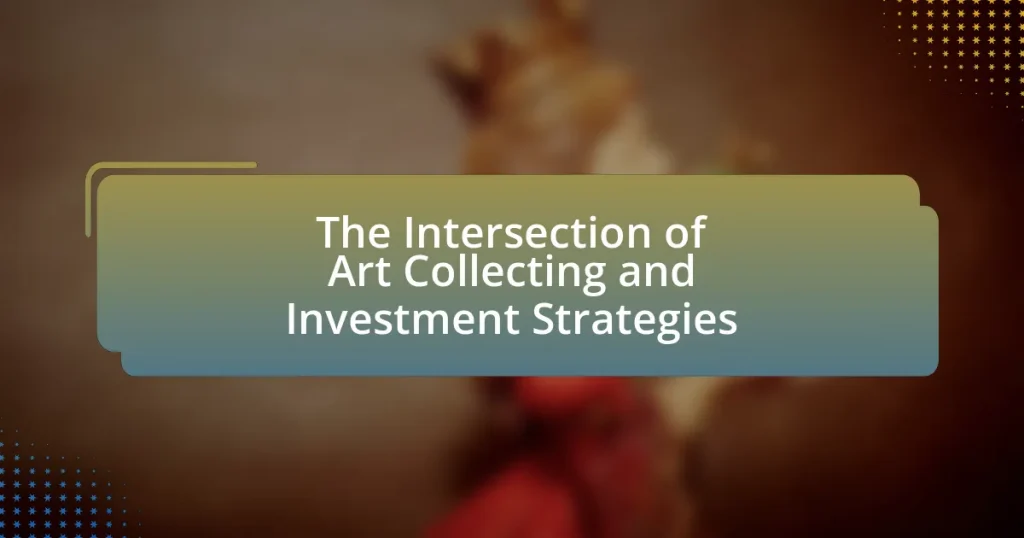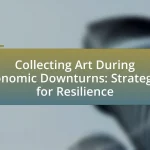The article examines the intersection of art collecting and investment strategies, highlighting art as an alternative asset class with significant appreciation potential. It discusses the motivations behind art collecting as an investment, including financial appreciation, portfolio diversification, and personal enjoyment. The article also outlines how the art market functions as an investment vehicle, the impact of various art forms on investment potential, and the roles of galleries and auction houses in determining art value. Additionally, it addresses the risks associated with art investments, common pitfalls to avoid, and best practices for building a diversified art portfolio.
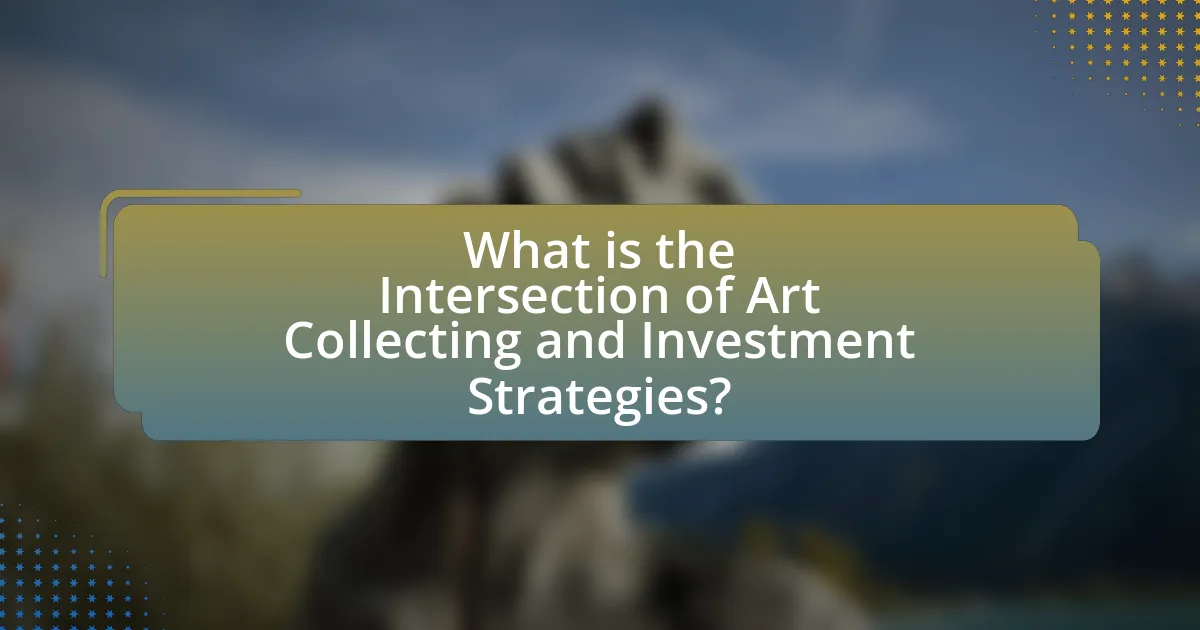
What is the Intersection of Art Collecting and Investment Strategies?
The intersection of art collecting and investment strategies lies in the recognition of art as an alternative asset class that can appreciate in value over time. Art collectors often view their acquisitions not only as aesthetic investments but also as financial assets that can yield returns, similar to stocks or real estate. According to a report by Artprice, the global art market saw a 29% increase in sales in 2021, indicating strong investment potential. Additionally, the annual Art Basel and UBS Global Art Market Report highlights that high-value artworks can appreciate significantly, with some pieces doubling in value over a decade. This dual perspective encourages collectors to apply investment strategies, such as diversification and market analysis, to their art portfolios, thereby merging passion with financial acumen.
How do art collecting and investment strategies relate to each other?
Art collecting and investment strategies are closely related as both involve the acquisition of assets with the expectation of future value appreciation. Collectors often view art as a tangible asset that can diversify their investment portfolios, similar to stocks or real estate. According to a report by Art Basel and UBS, the global art market reached $65.1 billion in sales in 2019, indicating significant financial interest and potential returns in art investments. Furthermore, art can provide a hedge against inflation, as its value may increase over time, aligning with traditional investment strategies aimed at wealth preservation and growth.
What are the key motivations behind art collecting as an investment?
The key motivations behind art collecting as an investment include the potential for financial appreciation, diversification of investment portfolios, and the enjoyment of ownership. Financial appreciation is significant, as art has historically shown a strong return on investment; for instance, the Artprice Global Art Market Report indicates that the global art market has grown by 10% annually over the past decade. Diversification is another motivation, as art can provide a hedge against market volatility, allowing investors to spread risk across different asset classes. Additionally, collectors often derive personal satisfaction and cultural enrichment from owning art, which can enhance the overall value of their investment beyond mere financial metrics.
How does the art market function as an investment vehicle?
The art market functions as an investment vehicle by allowing collectors and investors to purchase artworks that can appreciate in value over time. Artworks, particularly those by renowned artists, can yield significant returns; for instance, a study by Artprice indicates that the global art market grew by 29% in 2021, highlighting the potential for capital gains. Additionally, art can serve as a hedge against inflation, as tangible assets often retain value when currency depreciates. The liquidity of the art market, facilitated by auctions and galleries, further enhances its attractiveness as an investment, enabling investors to sell pieces when market conditions are favorable.
Why is art considered a viable investment option?
Art is considered a viable investment option because it has historically appreciated in value and can provide diversification in an investment portfolio. The global art market has shown resilience, with the total sales reaching approximately $65 billion in 2021, according to the Art Basel and UBS Global Art Market Report. Additionally, art can act as a hedge against inflation, as tangible assets often retain value when currency depreciates. Furthermore, high-quality artworks from established artists tend to increase in value over time, making them attractive for long-term investment.
What historical trends support art as an investment?
Art has historically demonstrated strong investment potential, evidenced by its appreciation in value over time. For instance, the Mei Moses Art Index, which tracks the price performance of fine art, shows that art has outperformed traditional investments like stocks and bonds over the past 50 years, with an average annual return of approximately 10.5%. Additionally, during economic downturns, art often retains its value better than other asset classes, as seen during the 2008 financial crisis when the art market showed resilience compared to stock market volatility. Furthermore, auction records, such as the sale of Leonardo da Vinci’s “Salvator Mundi” for $450 million in 2017, highlight the extreme value that can be achieved in the art market, reinforcing its status as a viable investment.
How does art compare to traditional investment assets?
Art is generally considered a less liquid and more volatile investment compared to traditional assets like stocks and bonds. While traditional investments often provide measurable returns and are regulated, art investments can fluctuate significantly in value based on market trends, artist reputation, and economic conditions. For instance, according to a report by Artprice, the global art market saw a 29% increase in sales in 2021, showcasing its potential for high returns, yet it also experienced downturns during economic recessions, unlike more stable traditional assets. Additionally, art does not generate income like dividends or interest, making it a different type of investment strategy that requires a longer-term perspective and a deeper understanding of the art market.
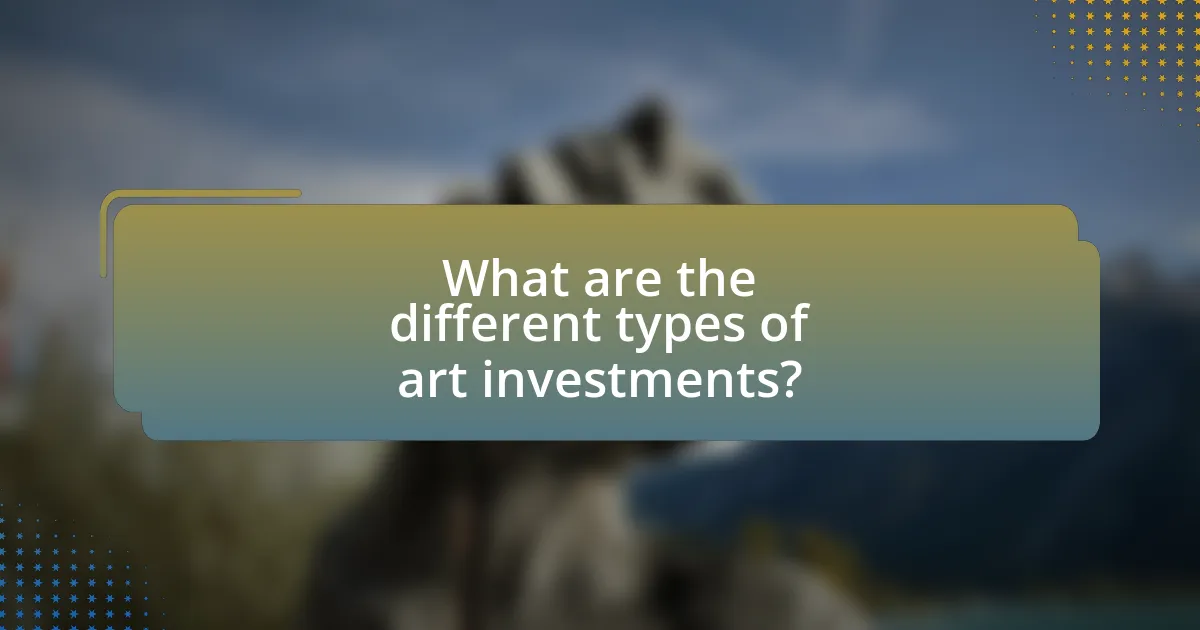
What are the different types of art investments?
The different types of art investments include contemporary art, modern art, old masters, photography, and collectibles such as sculptures and prints. Contemporary art, which encompasses works created from the late 20th century to the present, often attracts high prices at auctions, with sales reaching millions for prominent artists like Jeff Koons. Modern art, covering the late 19th to mid-20th century, also sees significant investment, with pieces by artists like Pablo Picasso commanding high values. Old masters, referring to European artists from the 14th to the 18th centuries, remain sought after, with works by Rembrandt and Vermeer fetching record prices. Photography has emerged as a viable investment category, with works by renowned photographers like Ansel Adams appreciating in value. Additionally, collectibles such as sculptures and limited edition prints can provide diversification in an art investment portfolio, often appreciating based on artist reputation and market demand.
How do various art forms impact investment potential?
Various art forms significantly impact investment potential by influencing market demand, liquidity, and appreciation rates. For instance, contemporary art has seen a surge in investment interest, with sales at auction houses like Sotheby’s and Christie’s reaching record highs, indicating strong market demand. Additionally, specific art forms, such as photography and digital art, have emerged as viable investment options, with the NFT market alone generating over $10 billion in sales in 2021, showcasing their liquidity and potential for appreciation. Historical data also supports that certain genres, like Impressionism, have consistently outperformed traditional investments, with a 10% annual return over the past 20 years, further validating the investment potential of various art forms.
What are the differences between contemporary and classical art investments?
Contemporary art investments differ from classical art investments primarily in terms of market dynamics and risk profiles. Contemporary art, often created by living artists, tends to have a more volatile market influenced by trends, artist reputation, and cultural relevance, leading to higher potential returns but also greater risks. In contrast, classical art, which includes works from historical periods, typically has a more stable market due to established provenance and historical significance, resulting in lower volatility and often more predictable appreciation over time. For instance, the global art market report from Art Basel and UBS in 2021 indicated that contemporary art sales reached $2.7 billion, showcasing its growing market, while classical art remains a staple for long-term investors seeking stability.
How does the medium of art (painting, sculpture, etc.) affect its value?
The medium of art significantly affects its value due to factors such as rarity, historical significance, and market demand. For instance, paintings often command higher prices than sculptures because they are more widely recognized and collected, with iconic works by artists like Leonardo da Vinci or Vincent van Gogh fetching hundreds of millions at auction. Additionally, certain mediums may have a more limited supply; for example, bronze sculptures are often produced in smaller editions, which can enhance their value. Market trends also play a crucial role; contemporary art in mediums like digital or installation art has seen a surge in value as collectors seek innovative forms. Thus, the medium not only influences the intrinsic qualities of the artwork but also shapes its perceived worth in the art market.
What role do art galleries and auction houses play in art investment?
Art galleries and auction houses serve as critical intermediaries in art investment by facilitating the buying and selling of artworks, thereby influencing market dynamics. Galleries often curate collections, promote artists, and provide valuation services, which helps investors identify potential art assets. Auction houses, on the other hand, conduct public sales that establish market prices through competitive bidding, offering transparency and liquidity to investors. For instance, in 2021, Sotheby’s reported a record $7.3 billion in sales, highlighting the significant role auction houses play in determining the value of art as an investment. This interplay between galleries and auction houses not only shapes investor confidence but also impacts the overall art market by setting trends and establishing provenance, which are essential for assessing the long-term value of art investments.
How do galleries influence the value of art pieces?
Galleries influence the value of art pieces primarily through their role in establishing credibility and market demand. By curating exhibitions, promoting artists, and providing a platform for visibility, galleries can significantly enhance an artist’s reputation, which in turn elevates the perceived value of their work. For instance, a study by the Art Market Research in 2020 indicated that artworks exhibited in reputable galleries saw a price increase of up to 30% compared to those sold in less recognized venues. Additionally, galleries often set pricing standards and create scarcity through selective representation, further driving up the value of the art they showcase.
What is the significance of auction results in determining art value?
Auction results are significant in determining art value as they provide a transparent and quantifiable measure of what buyers are willing to pay for specific artworks. These results reflect market demand, artist reputation, and the rarity of the piece, which are critical factors in establishing value. For instance, a record-breaking sale at auction can elevate an artist’s status and influence future pricing, as seen when Jean-Michel Basquiat’s painting sold for $110.5 million in 2017, significantly impacting the market for contemporary art. Thus, auction results serve as a benchmark for collectors and investors, guiding their decisions based on real-time market dynamics.
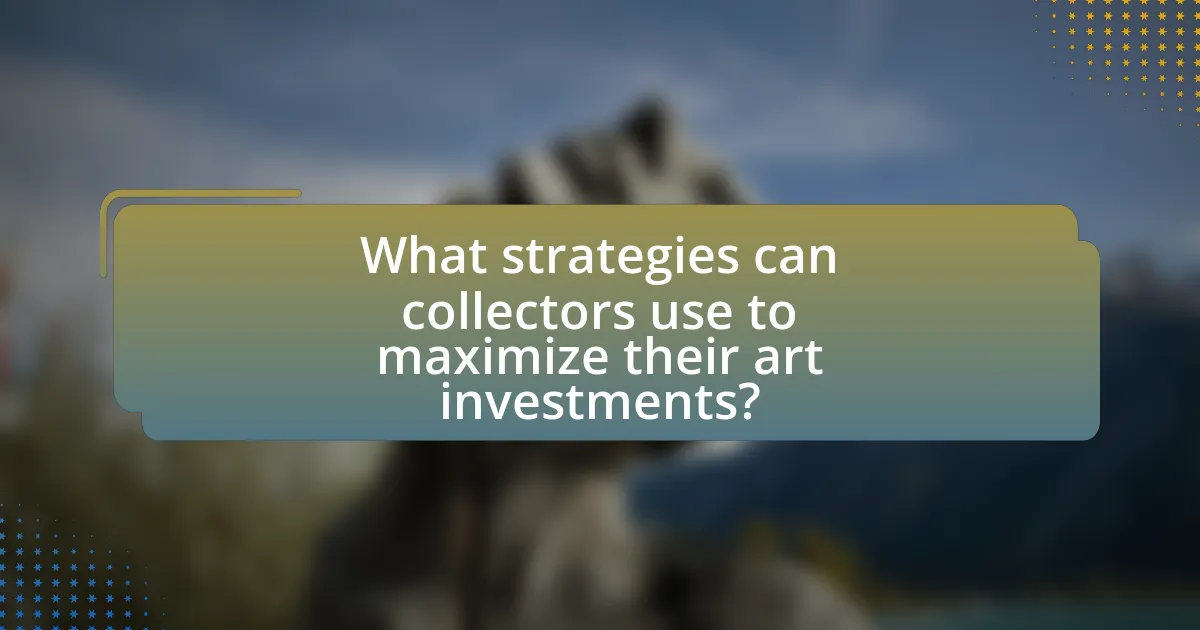
What strategies can collectors use to maximize their art investments?
Collectors can maximize their art investments by conducting thorough research on artists, market trends, and historical performance of artworks. This strategy involves analyzing auction results, gallery sales, and the reputation of artists to identify undervalued pieces with potential for appreciation. For instance, a study by Artprice indicates that contemporary art has seen an average annual return of 10% over the past decade, highlighting the importance of informed purchasing decisions. Additionally, diversifying a collection across different styles, periods, and mediums can mitigate risk and enhance overall value. Engaging with art advisors and attending art fairs can also provide insights into emerging artists and market dynamics, further supporting investment growth.
How can collectors assess the value of art before purchasing?
Collectors can assess the value of art before purchasing by conducting thorough research on the artist, the artwork’s provenance, and market trends. Understanding the artist’s background, including their exhibition history and critical reception, provides insight into the potential future value of the artwork. Provenance, or the artwork’s ownership history, can significantly affect its value; artworks with well-documented provenance tend to command higher prices. Additionally, analyzing current market trends, including auction results and sales data from reputable galleries, helps collectors gauge the demand and pricing for similar works. For instance, a report from Artprice indicates that contemporary art prices have increased by 10% annually over the past decade, highlighting the importance of market analysis in valuation.
What factors should be considered when evaluating an artwork’s investment potential?
When evaluating an artwork’s investment potential, factors such as the artist’s reputation, market demand, provenance, condition, and historical significance must be considered. The artist’s reputation influences perceived value; for instance, works by established artists like Pablo Picasso often appreciate more than those by lesser-known creators. Market demand can be assessed through auction results and gallery sales, indicating how much collectors are willing to pay. Provenance, or the artwork’s ownership history, adds to its value, especially if it has been owned by notable collectors or institutions. The condition of the artwork affects its desirability; pieces in excellent condition typically command higher prices. Lastly, historical significance can enhance an artwork’s investment potential, as pieces that represent important movements or events in art history tend to appreciate over time.
How can provenance and authenticity affect an artwork’s value?
Provenance and authenticity significantly influence an artwork’s value by establishing its historical ownership and verifying its legitimacy. Provenance provides a documented history of an artwork, which can enhance its desirability and market price; for instance, artworks with a well-documented lineage often command higher prices at auctions. Authenticity, confirmed through expert verification or certificates, assures buyers that the artwork is genuine, thereby preventing fraud and increasing buyer confidence. According to a report by Artprice, artworks with verified provenance and authenticity can see value increases of up to 50% compared to those lacking such documentation.
What are the risks associated with art collecting as an investment?
Art collecting as an investment carries several risks, including market volatility, authenticity concerns, and illiquidity. Market volatility can lead to significant fluctuations in art prices, making it difficult for collectors to predict returns. Authenticity concerns arise from the potential for counterfeit works or misattributed pieces, which can diminish value and lead to financial loss. Illiquidity is another risk, as selling art can take time and may not yield immediate cash, unlike more liquid investments such as stocks or bonds. According to a report by Artprice, the art market can experience drastic price changes, with some segments seeing annual fluctuations of over 20%.
How can market fluctuations impact art investments?
Market fluctuations can significantly impact art investments by altering the perceived value and demand for artworks. When economic conditions are unstable, collectors may prioritize liquidity over luxury purchases, leading to decreased sales and lower prices in the art market. For instance, during the 2008 financial crisis, the global art market saw a decline of approximately 30% in sales, demonstrating how economic downturns can directly affect art valuations. Additionally, fluctuations in currency exchange rates can influence international art sales, as collectors may be deterred by unfavorable rates. Thus, the interplay between market conditions and art investments is evident, with economic trends directly shaping buyer behavior and pricing dynamics.
What are the common pitfalls to avoid in art investing?
Common pitfalls to avoid in art investing include lack of research, emotional buying, neglecting provenance, and ignoring market trends. Investors often fail to conduct thorough research on artists and artworks, which can lead to poor investment choices. Emotional buying occurs when investors purchase art based on personal feelings rather than market value, resulting in overpaying. Neglecting provenance, or the history of ownership of an artwork, can lead to issues with authenticity and value. Additionally, ignoring market trends can result in investing in artworks that may not appreciate over time, as seen in fluctuating art market indices.
What best practices should art collectors follow for successful investments?
Art collectors should conduct thorough research and due diligence before making investments. This involves understanding the art market, including trends, artist reputations, and historical performance of artworks. For instance, a study by Artprice indicates that the global art market has seen an annual growth rate of approximately 5% over the last decade, highlighting the importance of informed decision-making. Additionally, collectors should diversify their portfolios by investing in various artists and styles to mitigate risks. Engaging with reputable galleries and auction houses can also provide valuable insights and access to high-quality pieces. Finally, maintaining proper documentation and provenance for each artwork ensures authenticity and can enhance resale value.
How can collectors build a diversified art portfolio?
Collectors can build a diversified art portfolio by acquiring works from various genres, periods, and mediums. This approach minimizes risk and enhances potential returns by spreading investments across different types of art, such as contemporary, modern, and classical pieces. Additionally, collectors should consider investing in emerging artists alongside established ones, as this can provide opportunities for significant appreciation in value. According to a report by Artprice, the global art market saw a 29% increase in sales in 2021, indicating that diversification can lead to better financial outcomes. By focusing on a mix of styles and artists, collectors can create a balanced portfolio that is less susceptible to market fluctuations.
What resources are available for art investment education?
Resources available for art investment education include online courses, books, and industry reports. Online platforms like Coursera and MasterClass offer courses specifically focused on art investment strategies, taught by experts in the field. Books such as “The Art of Investing in Art” by David H. Hurst provide in-depth insights and practical advice on navigating the art market. Additionally, industry reports from organizations like Art Basel and UBS, which publish annual Art Market Reports, offer valuable data and analysis on market trends, helping investors make informed decisions. These resources collectively enhance understanding and knowledge in art investment.










